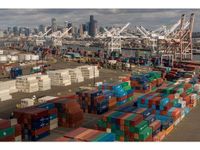The U.S. trade deficit showed signs of contraction in February 2025, as the gap in goods and services trade narrowed by 6.1% from the previous month, settling at $122.7 billion. This development comes in the wake of President Donald Trump's recent tariff announcements, which have sparked concerns about potential global economic repercussions.
According to data released by the Commerce Department on April 3, 2025, exports rose by 2.9% in February, indicating a slight recovery in international trade dynamics. These figures, however, are not adjusted for inflation, which remains a critical factor affecting the overall economic landscape.
Despite the positive uptick in exports, the trade report highlighted a decline in merchandise imports, which fell slightly due to reduced demand for industrial materials. Categories such as business equipment, consumer goods, and motor vehicles saw increases, underscoring a complex trade environment influenced by recent tariff policies.
On April 2, 2025, President Trump announced a set of reciprocal tariffs with a baseline rate of 10% globally, but with significantly higher levies imposed on countries like China and Vietnam. This move aims to ensure fairness in bilateral trade, encourage foreign investment, and bolster domestic production. Trump's administration has already implemented a 25% tariff on certain goods from Canada and Mexico, as well as a global duty on aluminum and steel, which has led to heightened tensions in international trade relations.
The February trade report also indicated a narrowing of the merchandise-trade shortfall with Canada, while the deficit with Mexico reached a record high. Notably, the trade deficit with China also narrowed, largely due to a decrease in the value of goods exported to the U.S.
In Canada, however, the situation was markedly different. Statistics Canada reported that the country's merchandise trade balance fell to a deficit of $1.5 billion in February 2025, a stark contrast to the surplus of $3.1 billion recorded in January. This downturn was attributed to a sharp decline in exports, particularly in energy products, which dropped by 6.3%.
Katherine Judge, a senior economist at CIBC, noted that a previous boost in exports due to tariff anticipation reversed sharply in February. "Looking ahead, U.S. businesses appear to have accumulated enough inventory in prior months, and exports will remain under pressure as a result," Judge stated.
Canada's total exports fell by 5.5% to $70.1 billion in February, with significant drops in crude oil and refined petroleum product exports, which fell by 4.2% and 15.3%, respectively. Meanwhile, total imports increased by 0.8% to $71.6 billion, driven by a rise in motor vehicles and industrial machinery imports.
As the trade dynamics shift, Canadian Finance Minister François-Philippe Champagne reassured the public that access to food would remain stable despite the imposition of steep foreign tariffs on agricultural and seafood products. He emphasized the importance of Canada’s ability to produce its own food, stating, "Our agriculture and agri-food sectors ensure that Canadians wherever they live in our big country have access to fresh, nutritious and affordable food."
Champagne's remarks came in light of concerns that tariffs could significantly impact Canadian farmers. Agriculture Minister Kody Blois previously warned of the severe consequences of foreign tariffs, particularly after China imposed hefty surtaxes on Canadian canola and peas, along with 25% tariffs on pork and seafood.
To mitigate the effects of these tariffs, the Canadian government has proposed a $200 million Domestic Food Processing Fund aimed at enhancing domestic processing capacity. Additionally, loan guarantee limits under the Canada Agricultural Loans Act have been doubled to $1 million, and the revenue protection under the AgriStability Program has been increased from $3 million to $6 million per farmer.
Despite these challenges, Canada remains a major player in global food exports, ranking as the eighth largest food exporter worldwide, with U.S. buyers accounting for 60% of sales. A recent study by Leiden University ranked Canada as the fourth most self-sufficient country globally, highlighting its capacity to sustain its population without heavy reliance on imports.
As the trade landscape continues to evolve under the pressures of new tariffs and shifting global demand, both the U.S. and Canada face significant challenges. The U.S. trade deficit is likely to widen in the first quarter of 2025, as noted by economists, while Canadian exports remain under pressure from U.S. tariffs and the broader economic implications of these trade policies.
In conclusion, the interplay between U.S. and Canadian trade policies will be crucial to watch in the coming months. Both nations are navigating a complex web of tariffs and trade balances, with far-reaching implications for their economies and the global market.






